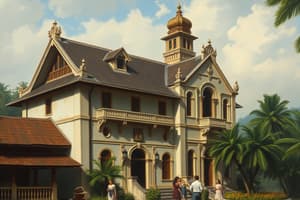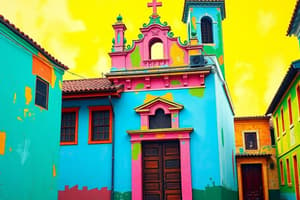Podcast
Questions and Answers
What was the primary focus of architecture during the pre-colonization era in the Philippines?
What was the primary focus of architecture during the pre-colonization era in the Philippines?
- Construction of large urban centers
- Development of complex architectural styles
- Use of local materials for simple structures (correct)
- Involvement of foreign architects
Which characteristic best describes the architectural style prevalent before colonization?
Which characteristic best describes the architectural style prevalent before colonization?
- Renaissance influences and symmetry
- Use of advanced engineering techniques
- Integration with the natural environment (correct)
- Focus on monumental structures
What role did local culture play in pre-colonization architecture in the Philippines?
What role did local culture play in pre-colonization architecture in the Philippines?
- It promoted the use of standardized, overseas designs.
- It dictated strict architectural guidelines and rules.
- It inspired unique forms and functions in structures. (correct)
- It had little to no influence on design choices.
How did the environment affect architectural practices in the Philippines before colonization?
How did the environment affect architectural practices in the Philippines before colonization?
Which of the following would NOT be a likely characteristic of pre-colonization architecture?
Which of the following would NOT be a likely characteristic of pre-colonization architecture?
Which material was primarily used in constructing buildings during the pre-colonization era in the Philippines?
Which material was primarily used in constructing buildings during the pre-colonization era in the Philippines?
What type of structures were commonly built in pre-colonization Philippine architecture?
What type of structures were commonly built in pre-colonization Philippine architecture?
Which geographical feature played a crucial role in shaping pre-colonization architecture in the Philippines?
Which geographical feature played a crucial role in shaping pre-colonization architecture in the Philippines?
Which of the following influenced the design choices in pre-colonization Philippine architecture?
Which of the following influenced the design choices in pre-colonization Philippine architecture?
What was a common function of communal structures in pre-colonization Filipino villages?
What was a common function of communal structures in pre-colonization Filipino villages?
How did the climate of the Philippines influence architectural design in the pre-colonization era?
How did the climate of the Philippines influence architectural design in the pre-colonization era?
What type of roof was commonly found in pre-colonization architecture in the Philippines?
What type of roof was commonly found in pre-colonization architecture in the Philippines?
Which characteristic was NOT typical of pre-colonization Philippine architecture?
Which characteristic was NOT typical of pre-colonization Philippine architecture?
What was a primary purpose of the architectural layout in pre-colonization Filipino communities?
What was a primary purpose of the architectural layout in pre-colonization Filipino communities?
Which of these features was NOT commonly integrated into the architectural designs of pre-colonization structures?
Which of these features was NOT commonly integrated into the architectural designs of pre-colonization structures?
Flashcards
Pre-colonial Filipino architecture
Pre-colonial Filipino architecture
Architectural styles and practices in the Philippines before Spanish colonization.
Bahay Kubo
Bahay Kubo
A traditional Filipino house.
Balete Tree Houses
Balete Tree Houses
Houses built using native Filipino beliefs and practices, incorporating the balte tree.
Rice Terraces of Banaue
Rice Terraces of Banaue
Signup and view all the flashcards
Sustainable Materials
Sustainable Materials
Signup and view all the flashcards
Tropical Climate Adaptation
Tropical Climate Adaptation
Signup and view all the flashcards
Indigenous Beliefs
Indigenous Beliefs
Signup and view all the flashcards
Indigenous Building Techniques
Indigenous Building Techniques
Signup and view all the flashcards
Utilitarian Function
Utilitarian Function
Signup and view all the flashcards
Symbolic Function
Symbolic Function
Signup and view all the flashcards
Environmental Influence
Environmental Influence
Signup and view all the flashcards
Pre-Colonial Era
Pre-Colonial Era
Signup and view all the flashcards
Indigenous Architecture
Indigenous Architecture
Signup and view all the flashcards
Building Materials
Building Materials
Signup and view all the flashcards
Sociocultural Influences
Sociocultural Influences
Signup and view all the flashcards
Study Notes
Pre-Colonial Era Architecture in the Philippines
- Filipinos developed unique architectural styles before Spanish colonization.
- Pre-colonial houses were often built with sustainably sourced materials, including bamboo, nipa palm, and wood.
- These structures were designed to cope with the tropical climate and frequent typhoons.
- Traditional designs were often influenced by indigenous beliefs and practices.
- Notable architectural forms included Bahay Kubo (traditional Filipino house), Balete Tree Houses, and the Rice Terraces of Banaue.
- Pre-colonial architecture served utilitarian and symbolic functions, reflecting communal values and a deep connection to nature.
- This period saw the use of indigenous techniques and materials, demonstrating sustainable practices relevant to the local environment.
- Pre-colonial architecture lays the foundation for the diverse and vibrant architectural traditions of the Philippines.
Pre-Colonization Era
- The text focuses on the pre-colonial era, suggesting the study of architectural practices and styles before Spanish colonization in the Philippines.
- The large amount of "Pre-Colonization Era" text indicates the importance of understanding this period in Philippine architectural history.
- This section likely delves into the unique building techniques, materials, and architectural forms developed by indigenous Filipinos prior to Spanish influence.
- Key topics within this era could include:
- Indigenous Architecture: The styles and construction methods of different Filipino ethnic groups.
- Materials: Focus on traditional materials like bamboo, wood, and thatch.
- Building Techniques: Discussions on local construction techniques like raised houses on stilts, unique roof structures, and intricate carvings.
- Religious Structures: Evidence of religious practices and the architectural forms used to build sacred spaces.
- Sociocultural Influences: How the environment and social needs of different groups influenced their architectural practices.
Studying That Suits You
Use AI to generate personalized quizzes and flashcards to suit your learning preferences.




